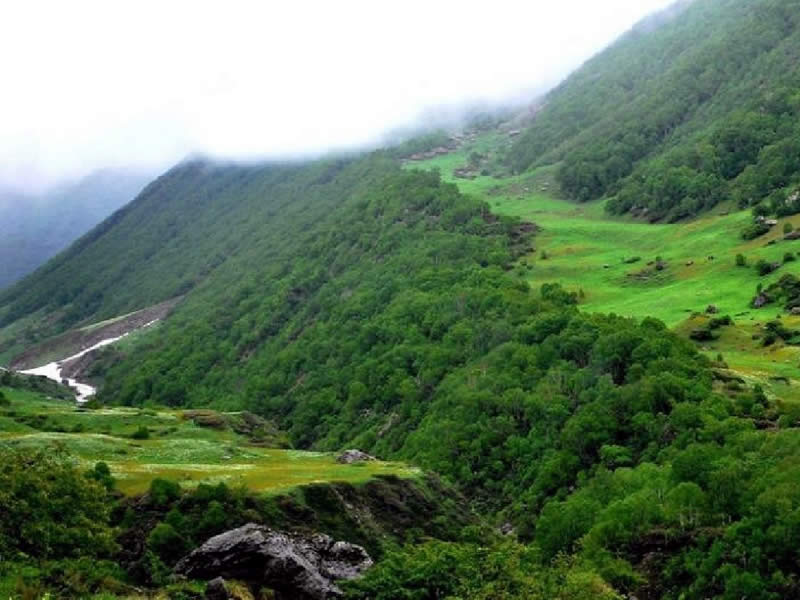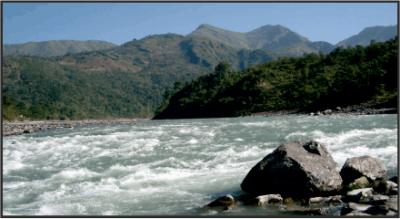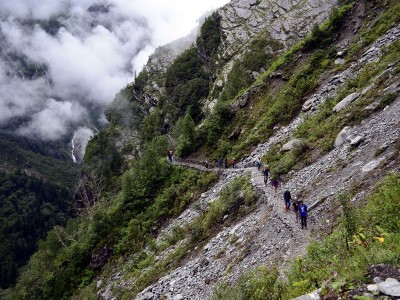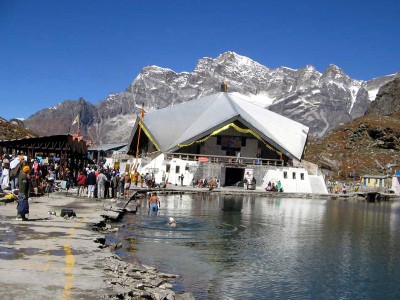Valley of Flowers Tourism and Travel Guide
Recognised as a UNESCO world heritage site, valley of flowers is a national park located in Uttarakhand and is known for its rich diversity in flora and fauna. The valley is a reserve for hundreds of flowers species such as Orchids, Poppies, Primula, Calendulas, Iris, Lily, Roses, Violets, Rhododendron, Angelica, Himalayan Fritillary, Daisies and Anemones. It is also a home to animals such as the Himalayan Tahr, Snow Leopard, Musk Deer, Red Fox, Common Langur (a type of monkey), Bharal, Serow, Himalayan Black Bear, Himalayan Brown Bear, Pica (Mouse hare) and a huge variety of butterflies. It's also a reserve for many birds consisting of Himalayan Golden Eagle, Griffon Vulture, Snow Partridge, Himalayan Snow Cock, Himalayan Monal, Snow Pigeon, and Sparrow Hawk among others. Waterfalls are also in abundance here.
Valley of Flowers is located on the upper extension of Bhyundar Ganga, Zanskar range of the Himalayas in Chamoli District of Uttarakhand. In 1931, Frank S. Smith had gone for an expedition, but lost his way while returning back. He accidentally reached a place and found exotic species of flowers there, and named it the Valley of Flowers. He later wrote a book of the same name. After that, in 1939 Royal Botanic Gardens, Kew deputed a botanist Joan Margaret Legge to valley to study flowers, but unfortunately she slipped on the rocky slopes while collecting flowers and died. Her sister later visited the valley and erected a memorial near the spot. Wildlife Institute of India also assigned a botanist Prof. Chandra Prakash Kala to carry out research in the valley and study flowers. He did an extensive research and wrote two books- The Valley of Flowers - Myth and Reality and Ecology and Conservation of the Valley of Flowers National Park, Garhwal Himalaya. The Valley of Flowers was declared a national park in 1982. According to legends, to cure Lakshman, Hanuman had collected Sanjeevani buti from this place.
Best Time to Visit:
Valley of Flowers is open from June to October, but the best time to visit it is between the months of July to September after the monsoon rains end and the whole valley looks decorated with the exotic flowers and their enchanting fragrance draws more and more tourists. It is covered under the white sheet during winters.
Tickets and Charges: -
The charges for an entry permit to the valley of flowers are nominal, however extra charges are there for still cameras. You need to get written permission from the Chief Wildlife Warden to take video recorders inside the park. The entry permits are available from the Forest Check Post at the entrance to the park, beyond Ghangaria.
The park is administered by the Uttarakhand State Forestry Department, the national Ministry of Environment and Forests, India. Grazing in the area is strictly prohibited since 1983.
How to Reach:
A colourful paradise, valley of flowers is located 300 Km North of Rishikesh, near Badrinath. You need to Travel by Road till Govindghat and from there the trek to Valley of Flowers starts. Govindghat is 20 Km before Badrinath. Till Govindghat there is a motor-able Road. Rishiksh is six hours drive from New Delhi, India.
About Nanda Devi and Valley of Flowers National Parks:
The Nanda Devi National Park was established in 1982, is around the peak of Nanda Devi (7816 metres) in the state of Uttarakhand in northern India. The entire park lies at an elevation of more than 3,500 metres (11,500 ft) above sea level. In 2005, it was expanded and renamed to Nanda Devi and Valley of Flowers National Parks in 2005.










